Mark Sisson's Blog, page 213
August 8, 2016
Dear Mark: When Walking Is No Longer Enough; Fermented Foods and Depression
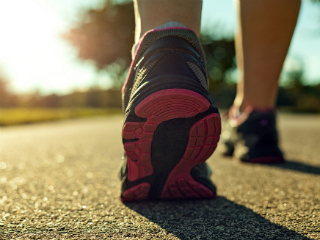 For today’s edition of Dear Mark, I’m answering two questions. First up, what happens when a brisk walk isn’t enough to attain the optimal fat-burning heart rate zone? It’s a good problem to have—better fitness—but it still needs a response. What activities can a person do to slightly increase the intensity without going over the target heart rate? And second, are fermented foods a potential cause of depression? If they have any effect on serotonin, could this cause problems rather than improvements?
For today’s edition of Dear Mark, I’m answering two questions. First up, what happens when a brisk walk isn’t enough to attain the optimal fat-burning heart rate zone? It’s a good problem to have—better fitness—but it still needs a response. What activities can a person do to slightly increase the intensity without going over the target heart rate? And second, are fermented foods a potential cause of depression? If they have any effect on serotonin, could this cause problems rather than improvements?
Let’s go:
Dear Mark,
I love walking and have lost 65 pounds over the last year and a half with that, combined with some basketball and, of course a primal diet. But walking no longer gets me into my “180-my age” range anymore, my heart rate stays 110 or so even at 4 mph. Running/jogging hurts my knees, so should I try the elliptical for my aerobic work, or just stick with fast walking even at a lower heart rate? Thanks and love the blog and podcast!
Vance
I’ve got good news and bad news, Vance.
The good news is that you’re officially fitter than when you started. If you’re able to walk at the same pace with a lower heart rate, you’re building that aerobic base, those new mitochondria. You’re becoming fat-adapted. Nice work.
The bad news (that isn’t really bad news) is that you’ll have to step it up a bit. But here’s another piece of good news: the “harder” work will only be as hard as walking used to be at your old heart rate because you’re more efficient at burning fat and you’ve got all those new mitochondria to play with. This is how an aerobic base opens up new doors and promotes the exploration of new types of movement. If last year a 5 mile uphill hike made you wheeze with regret, today that same hike will be a breeze. You’ll actually get to enjoy yourself, take in the views, and hold a conversation. The physical effort will be an afterthought.
That’s why the aerobic base is so important even for regular folks and non-elites: it improves your default mode of transportation. If before a slow walk along a sidewalk was as fast as you could go and still be comfortable, now a fast walk is your default. Your new normal becomes faster, better, stronger.
As for what you can do to hit that heart rate?
The elliptical is okay. I’m not a big fan, personally, especially for the high-volume, low-intensity movement you’ll be doing. The treadmill’s linearity is bad enough. Ellipticals are totally linear. Your movements literally follow a track, forcing repetition and replication. Any repetitive motion adds up. Sprinting on an elliptical? Sure. It’s over in a jiffy and provides the desired stimulus.
Try rucking. Load up a backpack with books and walk around wearing it. Start small, maybe 10-15 pounds. Move up as dictated by your heart rate. If things get heavy, use a pack with a hip belt to redistribute the weight. Weighted vests also work well here.
Do you have any hills near you? Go walk them.
As for the machines, an inclined treadmill can work.
Rowing is great. Just keep it nice and leisurely, like you’re a 19th century Manhattan fop taking his sweetheart out on the pond. Wouldn’t want to sweat through your linen suit.
Skipping is great, too. Kids know what they’re doing. If skipping’s too intense, skip for 10 paces, walk for 20.
A nice easy bike ride.
Swimming, too. Don’t forget about the pool.
Anything works. Just explore the different types of movement and watch your HR.
Hi,
Fermented foods, like kefir and kimchi, are often praised for their health benefits, one of which is their affect on serotonin and mood.
I’m wondering, concerned even, about possible long-term effects like serotonin depletion. This is something I observe in myself after prolonged periods of enthusiastic coffee consumption, short-term indulgences with wine, and (unfortunately) even a single dose of 90% dark chocolate. It also something I’ve read about in association with BCAA supplementation.
Should we be wary of a daily kefir habit too?
Richard
There are some strange things going on with serotonin and depression. It’s not a straightforward relationship. The common “neurotransmitter imbalance” model of depression where low serotonin causes depression isn’t quite accurate and has little actual evidence to support it. Anti-depressant drugs and supplements that don’t target serotonin, as well as non-pharmacological interventions like exercise, may be more effective than SSRIs against depression. If SSRIs work, it’s probably not by “increasing serotonin.”
In mice, probiotic administration increases serotonin turnover in the brain and reduces some of the inflammatory biomarkers associated with depression. Yet in humans, elevated serotonin turnover in the brain is a common feature of depression. Weird, eh?
The evidence is quite clear, though: fermented food intake is usually associated with low rates of depression in humans, not high rates.
Among pregnant Japanese women, high yogurt intake is protective against depressive symptoms.
Among Spanish university students, high-fat yogurt (but not low-fat yogurt) is protective against depression.
A recent trial in humans even found that a multi-species probiotic supplement made subjects more resistant to sad moods. These were healthy humans, not depressed ones, and depression is more than “sad mood,” but it’s promising.
The serotonin/fermented food question is up in the air. I’m not convinced, personally. But we have a conceivable mechanism by which fermented foods might exert protection against depression: improved gut health.
Leaky gut is common and seems to play a pathophysiological role in major depression; up to 35% of depressed patients have leaky gut. If your gut is too permeable, bacterial endotoxins/lipopolysaccharide (LPS) gain admittance to general circulation. And at least in mice, LPS induces depression.
Fermented food and probiotics can help. L. rhamnosus and L. reuteri supplements reduce leaky gut, and L. rhamnosus also helps restore the gut barrier in kids with acute gastroenteritis. In rats with leaky gut, yogurt improves gut barrier function.
I don’t think you should worry about this until it actually becomes a problem. Keep drinking that kefir and fermenting that cabbage.
That’s it for this week, folks. Now let’s hear from you.
Anyone had depressive symptoms worsen with fermented food intake? Improve?
What else can Vance do besides walk faster?
Thanks for reading!




August 7, 2016
Weekend Link Love – Edition 412
 Just a quick shout out to let you know that for the month of August, you can grab a digital copy of the following books for only $3.99 on Amazon: Death By Food Pyramid, Fruit Belly, and The Primal Prescription.
Just a quick shout out to let you know that for the month of August, you can grab a digital copy of the following books for only $3.99 on Amazon: Death By Food Pyramid, Fruit Belly, and The Primal Prescription.
You may not have a health coach, but you can still benefit from these 5 lessons.
Research of the Week
To counter all that sitting, you might need to train for an hour a day.
Resistant starch pancakes eaten with whey protein increase satiety and fat oxidation.
Early introduction of egg white and peanut to breastfed babies reduces their allergenicity.
Farm dust exposure in childhood might be the key to asthma prevention.
Is rest really best after a concussion?
Homes in wealthy neighborhoods have more bugs.
Resistant starch has a stronger effect on blood lipids, while fiber is better at improving glycemic control.
Lauric acid (primary MCT in coconut oil) stimulates ketone production in brain astrocytes.
Metformin users, be aware. B12 deficiency is common in people using metformin, and sometimes it causes peripheral neuropathy.
Danazol, a synthetic male steroid, preserves telomerase in humans and may reverse aging.
In middle aged women, high-intensity, low-volume swim sprints beat low-intensity, high-volume swimming for improving insulin sensitivity and glucose control.
New Primal Blueprint Podcasts

Episode 129: Sher Smith: Host Elle Russ hangs out with Sher Smith, a recent success story from Elle’s upcoming Paleo Thyroid Solution. They discuss Sher’s amazing journey from thyroid problems and eating disorders to easy Primal eating, exercising, and living.
Each week, select Mark’s Daily Apple blog posts are prepared as Primal Blueprint Podcasts. Need to catch up on reading, but don’t have the time? Prefer to listen to articles while on the go? Check out the new blog post podcasts below, and subscribe to the Primal Blueprint Podcast here so you never miss an episode.
Is Gluten Sensitivity All in Your Head?
10 Ways to Beat the Low-Carb Flu
How Language Affects Your Fitness and Weight Loss Practice
The Definitive Guide to Coffee
Take It Easy, Increase Progress: How to Make Your Training More Primal
Interesting Blog Posts
The Harvard research group can’t stop attacking butter. Why?
What does Primal productivity look like?
Fecal transplants work, but poop pills don’t.
Media, Schmedia
If you’re under 25, Peter Thiel may want your blood.
“…three of the Olympic 800m finalists might be intersex athletes.”
Leading nutritional scientists call for a new approach to studying diet and its effect on health: focus on foods in context, not nutrients in isolation.
Now they’re saying lean protein makes you fat.
Everything Else
Better than pesticides: 1000 ducks.
Better than soy: duck weed.
Never thought I’d read about a “yoga-fueled rampage,” but here we are.
The more we look, the more similar we are to the Neanderthal.
The McMuffin’s got real butter now.
A chef complains about home cooks.
Hey, you know what sounds great? An evidence-based policy for sodium intake.
Recipe Corner
Flourless herbed potato waffles (savory, not sweet).
Simple, basic, perfect, buttery: sole meuniére.
Time Capsule
One year ago (Aug 7 – Aug 13)
Is Conventional Wisdom about GMO Safety Correct? – My answer might surprise you.
Why I Paddle Board (and Why You Should Try It) – It’s how I “meditate,” exercise, and run into neighborhood cetaceans.
Comment of the Week
Should we instead change the name from cockroach milk to Beetlejuice?
August 6, 2016
Homemade Beef Hot Dogs
![Hot_Dogs[1]](https://i.gr-assets.com/images/S/compressed.photo.goodreads.com/hostedimages/1470564681i/19941053.jpg) Hot dogs have always had a reputation for being mystery meat. But this unsavory fact, plus a lot of other undesirable ingredients, still aren’t enough to keep hot dogs from being loved by kids, and kids at heart. While many markets now offer grass-fed, organic hot dogs, you can also take on the challenge of making healthier hot dogs yourself.
Hot dogs have always had a reputation for being mystery meat. But this unsavory fact, plus a lot of other undesirable ingredients, still aren’t enough to keep hot dogs from being loved by kids, and kids at heart. While many markets now offer grass-fed, organic hot dogs, you can also take on the challenge of making healthier hot dogs yourself.
Fresh and flavorful, homemade hot dogs can be made with meat of your choosing, taking the mystery out of it. This recipe is for all beef dogs, seasoned with a simple “hot dog” blend. You’ll need a meat grinder (unless the butcher grinds the meat for you), a food processor, and a sausage stuffer. You’ll also need natural sheep casings. Talk to your butcher ahead of time, in case they have to special order the casings. For hot dogs, sheep casings are best because they’re thinner.
Is making homemade hot dogs more expensive and time consuming than just buying “healthier” hot dogs at the store? Yes and yes. But if you want to know exactly what goes into the hot dogs you’re eating, and if you’re up for a fun culinary challenge, then this recipe is for you.
Servings: Approximately 15 dogs, depending on how long they are
Time in the Kitchen: 1.5 to 2 hours of hands-on cooking, plus 3 hours of chilling and/or cooking the meat
Ingredients:
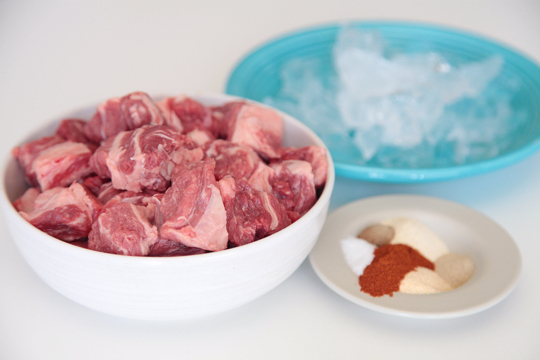
2 pounds/900 g well-marbled chuck, cut into 1-inch/2.5 cm cubes (or, ask your butcher to just grind the chuck for you)
1 teaspoon granulated onion (5 ml)
1 teaspoon granulated garlic (5 ml)
2 ½ teaspoons kosher salt (12 ml)
1 tablespoon sweet paprika (15 ml)
¼ teaspoons white pepper (1.25 ml)
¼ teaspoon ground coriander (1.25 ml)
¼ teaspoon nutmeg (1.25 ml)
1 cup crushed ice (a handful)
Sheep casings, about 24-26 mm in size
Instructions
If the temperature of the ground meat rises during the process of grinding, mixing and stuffing the hot dogs, the finished hot dogs will have a grainy texture. So, it’s important to keep the meat cold while working with it. Keeping all of your tools cold (grinder, stuffer, food processor bowl and blade) helps keep the meat cold. Before starting, put all your tools in the refrigerator so they are cold. Also, if you are grinding the meat yourself (instead of having your butcher do it), put the meat cubes in the freezer for 1 hour, to get the meat really cold before grinding it.
In a small bowl mix together the granulated onion, granulated garlic, salt, sweet paprika, white pepper, coriander and nutmeg. Set aside.
If the butcher has not already ground the chuck for you, grind the meat through the finest/smallest plate of your grinder. If the meat starts to come up to room temperature during the grinding process, set the bowl of ground meat in a larger bowl filled with ice water to keep the meat cold.
Add the spices to the ground meat, using your hands to blend it in really well (wetting your hands helps keep the meat from sticking). Put the meat back in the freezer for 15 minutes to chill.
Scrape the meat into a cold food processor bowl with half the ice. Process until the ice is blended in. Add the rest of the ice. Process until the ice is blended in and the mixture is very smooth, with a texture similar to thick batter. If the texture is not as smooth as you like, add a little bit of ice water. It should hopefully take no more than 5 minutes to reach the right texture.
Cover the mixture tightly with plastic wrap and chill at least 1 hour, or up to overnight.
While the meat chills, rinse the casings under cool running water to remove any salt. Place the casings in a bowl of cool water and let soak 30 minutes. Drain, and rinse under cool running water again.
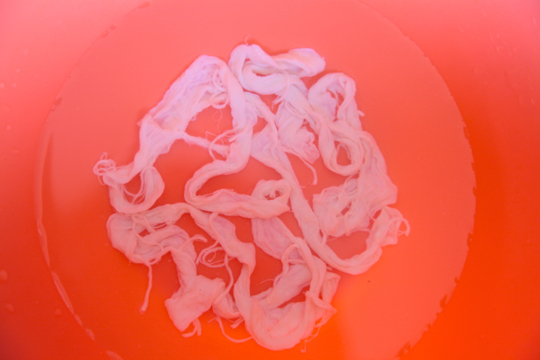
Use the stuffing attachment on a meat grinder to stuff the cold, seasoned meat into the casings. Twist the stuffed casing into the lengths of hot dogs you prefer.
*Need a helpful instructional video for grinding and stuffing sausage? Watch this one.
Once stuffed, par-boil the hot dogs in gently simmering water for 25 minutes. Plunge into ice water until the hot dogs are completely chilled. The hot dogs can be kept refrigerated for up to a week before eating.
To finish cooking right before serving, the hot dogs can be boiled, grilled, or cut open and seared in a cast iron skillet.
![Hot_Dog_on_Campfire[1]](https://i.gr-assets.com/images/S/compressed.photo.goodreads.com/hostedimages/1470564681i/19941056.jpg)
Like This Blog Post? Subscribe to the Mark's Daily Apple Newsletter and Get 10 eBooks and More Delivered to Your Inbox for FREE



August 5, 2016
Two Years Primal: Pain Free, Allergy Free and Fitter Than Ever
It’s Friday, everyone! And that means another Primal Blueprint Real Life Story from a Mark’s Daily Apple reader. If you have your own success story and would like to share it with me and the Mark’s Daily Apple community please contact me here. I’ll continue to publish these each Friday as long as they keep coming in. Thank you for reading!

My wife (a naturopathic physician) has always been interested in the pursuit of a healthful lifestyle. Wanting to lose the last 15 pounds, feeling a bit bloated and believing she may have issues with bacterial overgrowth, she started researching the paleo diet. After months of trying the paleo diet, she couldn’t figure out why it wasn’t helping, until she came across MDA (and read The Primal Blueprint) that she began to understand the importance of monitoring carbohydrate intake. As soon as she started abandoning starchier foods, she watched the numbers on the scale go down. Given that we enjoy cooking together, it was only natural for me to adopt the Primal lifestyle, too.
 I used to eat extremely un-healthfully and was very addicted to sugar. To give you an idea of how addicted I was, I often emptied seven packets of sugar in my cafeteria-sized coffee; I drank energy drinks every day with entire chocolate candy bars; I ate desert with every meal; every evening I consumed a pint of Ben and Jerry’s; every weekend I munched on doughnuts and each morning I had a fun, sugary cereal. My non-sugar “meals” (if you can call them that) consisted of the dollar cheeseburgers and meals at McDonalds. Dinner was usually the “healthiest” meal, which consisted of an array of cafeteria food or pizza. Of course, as aforementioned above, I completed my meal with desert and a Pepsi (water and I were not friends back then).
I used to eat extremely un-healthfully and was very addicted to sugar. To give you an idea of how addicted I was, I often emptied seven packets of sugar in my cafeteria-sized coffee; I drank energy drinks every day with entire chocolate candy bars; I ate desert with every meal; every evening I consumed a pint of Ben and Jerry’s; every weekend I munched on doughnuts and each morning I had a fun, sugary cereal. My non-sugar “meals” (if you can call them that) consisted of the dollar cheeseburgers and meals at McDonalds. Dinner was usually the “healthiest” meal, which consisted of an array of cafeteria food or pizza. Of course, as aforementioned above, I completed my meal with desert and a Pepsi (water and I were not friends back then).
I always knew that I wanted to eat more healthfully but I never really knew how to do so until my wife started coaching me on nutrition, sharing what she was learning from The Primal Blueprint, and I saw how well she responded to her diet changes. After a while, I slowly weaned myself off sugar and began eating more whole foods. However, it wasn’t until I fully switched to Primal that I began to understand how this lifestyle would truly impact my life.
Two months into the diet, I started to notice that my sciatica was not flaring up as frequently as it used to. In fact, prior to implementing my new eating habits, I experienced debilitating pain one to two times per month. It had been a 15-year struggle. Despite this breakthrough, I remained a bit skeptical of the reasons behind my two month sabbatical from pain. My skepticism was quickly halted after I attended a work function that offered foods such as Korean beef sliders and beer. I decided a little veering off of primal eating couldn’t hurt me too much. After indulging in wheat buns and beer, I had severe sciatica for a week following my binge and instantly I made the connection between carbohydrate-laden foods and inflammation in my back. I’ve since learned my lesson and I haven’t had any sciatica pain since that time.
Not only have I been pain free, but my seasonal allergies decreased significantly. The first year I started eating primal, when allergy season approached, I was able to switch from over the counter medications to natural nutraceuticals for two months or so, until the pollen count dwindled. The following year of remaining on The Primal Blueprint, I didn’t even need the natural supplements and only took a couple capsules once or twice during the entire season! In fact, my immune system seems to be operating so well that I have been able to bypass the cold and flu season each time it visits my colleagues at work. My co-workers have all been sick at least a half a dozen times in the last two years; however, it passed me by every time. While I did catch a minor cold after being cold free for two and a half years, it passed quickly and I haven’t been sick since. My boss actually had to ask me to call in “not sick” to use up my sick days because I hadn’t touched them.
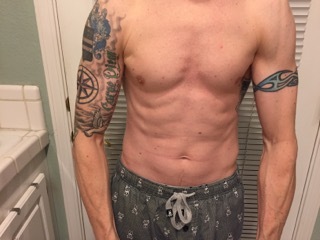 Along with the change in my diet, I have also been experimenting with high intensity interval training using body weight and strength-building exercises. I’ve been using Mark Lauren’s “You Are Your Own Gym” DVDs and have really benefited from the functional bodywork. I have incorporated a pull up bar into my workouts and have noticed a huge difference in my upper body strength. On the weekends, I enjoy a lengthy hike or walk with my wife. We’ve even incorporated play into our workouts by longboarding at the park. Even at 41, my wife enjoys longboarding with me. The results of working out 20 minutes three times per week have far outweighed the minimal results I experienced with my two-hour gym workouts. The at-home workouts have provided quick results and made cancelling my gym membership an easy decision, considering both the time and the money I was consuming trying to get fit. After just a few short months of working out in a more primal fashion, my belly fat has nearly disappeared and a six pack is starting to show. I was never a heavy guy or “overweight,” but I’ve always had a little fat layer over my belly. For the first time, my abdomen area is no longer pudgy.
Along with the change in my diet, I have also been experimenting with high intensity interval training using body weight and strength-building exercises. I’ve been using Mark Lauren’s “You Are Your Own Gym” DVDs and have really benefited from the functional bodywork. I have incorporated a pull up bar into my workouts and have noticed a huge difference in my upper body strength. On the weekends, I enjoy a lengthy hike or walk with my wife. We’ve even incorporated play into our workouts by longboarding at the park. Even at 41, my wife enjoys longboarding with me. The results of working out 20 minutes three times per week have far outweighed the minimal results I experienced with my two-hour gym workouts. The at-home workouts have provided quick results and made cancelling my gym membership an easy decision, considering both the time and the money I was consuming trying to get fit. After just a few short months of working out in a more primal fashion, my belly fat has nearly disappeared and a six pack is starting to show. I was never a heavy guy or “overweight,” but I’ve always had a little fat layer over my belly. For the first time, my abdomen area is no longer pudgy.
Now, two years into this lifestyle, my appetite for sweets is completely different. I used to want the entire candy bar, but now, two pieces of dark chocolate is enough to satisfy me. When it is doughnut day or pizza day at work, I am no longer tempted. Everyone at work thinks I am superhuman because I easily decline these foods, including birthday cake (which occurs often in a large office).
My typical meals now are relatively simple but very satisfying. For breakfast I have black coffee with a bit of butter, a protein smoothie with a few berries and a tons of greens. Lunch is usually more greens, grass-fed beef or organic chicken breast with a quality mayonnaise-based or avocado-based dressing. Snacks are usually nuts or pumpkin seeds and dinner is roasted veggies with salmon or grain-free meatballs or steak. Of course, most nights I indulge in a glass (or two) of quality dry red wine.
It is hard to say if I am mentally and emotionally any different, but I can go great lengths without eating and not feel like I’m going to go crazy. Before I changed my eating habits, I experienced low blood sugar symptoms (i.e. crankiness) that often accompany glucose deregulation. These days, skipping a meal here and there is no big deal.
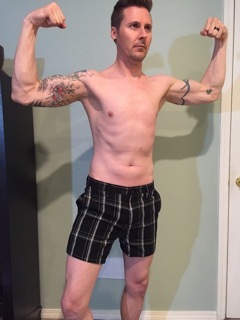 Overall, the primal lifestyle has completely overhauled my health, my body composition and my outlook on life. I am pain free, I am allergy free, I am nearly cold and flu free, I am gym membership free, I am time-sucking-workout free, I am prescription free and I am food addiction free. The best part is that I don’t feel like I am missing out on anything! The recipes on the MDA resource list are all incredible. My wife and I like the Nom Nom Paleo cookbook as well and have even enjoyed creating recipes of our own that fit the primal parameters. I love that I still get to enjoy red wine and dark chocolate and I never feel deprived, now that my sugar addiction is gone. I can’t think of better preventative medicine than taking control of your health (and reversing symptoms) by simply changing what you stick your fork into!
Overall, the primal lifestyle has completely overhauled my health, my body composition and my outlook on life. I am pain free, I am allergy free, I am nearly cold and flu free, I am gym membership free, I am time-sucking-workout free, I am prescription free and I am food addiction free. The best part is that I don’t feel like I am missing out on anything! The recipes on the MDA resource list are all incredible. My wife and I like the Nom Nom Paleo cookbook as well and have even enjoyed creating recipes of our own that fit the primal parameters. I love that I still get to enjoy red wine and dark chocolate and I never feel deprived, now that my sugar addiction is gone. I can’t think of better preventative medicine than taking control of your health (and reversing symptoms) by simply changing what you stick your fork into!
Thank you, Mark, for sharing your knowledge and vast research on the proven benefits of this lifestyle. It has saved me many trips to a doctor’s office – both presently – and more importantly, in the future!
John
Like This Blog Post? Subscribe to the Mark's Daily Apple Newsletter and Get 10 eBooks and More Delivered to Your Inbox for FREE
Save



August 4, 2016
The Primal Competitive Instinct: What Is It Good for?
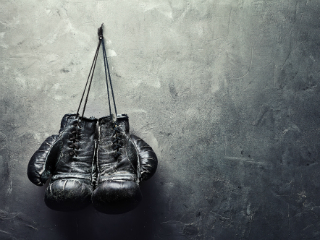 These days we have a mixed relationship with competition, and maybe rightfully so. As a culture, we struggle with the joys of simple play, the meaning of good sportsmanship, and the lightheartedness of a game well played. Life as we live it today can feel too serious, and the prospect of competition against that backdrop can feel like yet another layer of harshness, judgment or evaluation. To boot, those who have too much of a competitive spirit often demonstrate the least exemplary attitudes. I’d argue, however, that we throw the baby out with the bathwater when we push competition away instead of cultivating a healthy relationship with it.
These days we have a mixed relationship with competition, and maybe rightfully so. As a culture, we struggle with the joys of simple play, the meaning of good sportsmanship, and the lightheartedness of a game well played. Life as we live it today can feel too serious, and the prospect of competition against that backdrop can feel like yet another layer of harshness, judgment or evaluation. To boot, those who have too much of a competitive spirit often demonstrate the least exemplary attitudes. I’d argue, however, that we throw the baby out with the bathwater when we push competition away instead of cultivating a healthy relationship with it.
Trust me, I should know. As a recovered competitive endurance athlete, I’ve been on both sides of the tracks. It’s a big reason why I wrote Primal Endurance. As is often the case with Primal instincts, we can vilify competition with a one-dimensional assessment, or we can strategically harness it for our personal advantage. Now, with lots of experience under my belt, I always make a point to strive for the latter.
Sure, some of us are inevitably more drawn to competition than others, and we all gather energy from a unique mix of internal and external motivation. Nonetheless, we’re all born with the basic wiring. Competition is part of the human story after all. As a species, we’ve been propelled forward by the competitive edge time and again. Survival of the fittest may not mean as much in today’s world, but it was the principle that governed humanity’s evolution through the ages.
Although Grok’s time wasn’t necessarily characterized by the rampant violence conventional assumptions might lead us to believe, competition undoubtedly played out with random injustices, personal rivalries and mate competition. Yet, the egalitarian nature of social organization likely kept competition seated mostly in the realm of play rather than power. Even though band members might have enjoyed accolades or recognition for their hunting talents or inventive creativity, their status or well-being wouldn’t have changed much (except maybe being more attractive to potential love interests). On the individual level, competition, then, thrived more as a means of appeal rather than conflict.
But where competition mattered most perhaps was the larger context with group selection. The selfish gene, after all, wasn’t just about the individual in question. It was about group selection—oneself and one’s kin. How collaborative Grok could be (and even how altruistic at times), not only enhanced his appeal but also his and his band’s survival. It’s a different take than we often think of when we’re looking around the gym wondering whether we’ll ever be able to bench press what that other guy/gal can.
So, what should this mean for us today? What role can/should competition play in living a healthy life and propelling us forward? While not every health goal itself necessarily benefits from competition (e.g. the unhealthy conditions and long-term failure of The Biggest Loser approach to weight loss), competition can change how we apply ourselves to our goals. When viewed through the lens of play, it can be a boon for our growing sense of competence and self-discipline. We’re charged by more than the “shoulds” in our health aims and can engage on the level of game.
Let me throw out a few ideas for infusing your process with a competitive Primal spirit, and I hope you’ll add yours to the mix in the comment board.
Channel the group dynamic
Harness that “group survival” mentality, and get inspired to pull your weight in the tribe by joining a team sport like a hockey, Ultimate, a basketball league, or a group activity such as dancing, rowing, or mountaineering. Being in competitive group dynamics can be cathartic. It let’s you flex those proverbial (and literal) muscles without anyone getting hurt (usually). You get to contribute to a common goal along with your teammates while vying for victory. And if you have good sportsmanship, you can look forward to some deep social bonds; something which is good for longevity and overall happiness.
Engage in a little healthy comparison
Yes, comparison can be “the thief of joy” in some cases, but it can also spur us toward greater visions. Instead of indulging in jealousy, ask the person whose skill or strength you admire if they’d be interested in offering some advice on how he/she achieved success. Heck, if you both hit it off, you might have a new mentor as a result, which can be invaluable.
Challenge yourself to specific self-improvements
All athletes know they’re in constant competition with their previous performance first and foremost. Track your fitness numbers (e.g. pull-ups, push-ups, squats, plank time, reps, etc.), meditation minutes, sleep hours, pre-bedtime technology shutdown, or any other goal you have for yourself, and set short-term goals that push you to improve those markers. Engage your social networks by announcing and updating your intentions (humor will garner you enthusiastic support) on Facebook or Instagram. Nothing like group accountability to reinforce your commitment to personal progress.
Organize win-win scenarios
Trying to get yourself motivated to enhance your Primal way of eating? Host a Primal potluck and vow to bring your best cooking game to the event. Alternatively, channel your efforts for the greater good. Sign up for athletic charity events like walkathons and races, and push yourself to perform better all the while knowing your efforts are already benefiting a bigger cause. If you’re going to be competitive about something, you might as well have a positive byproduct to show for it. That’s something I’ve done all my life. I challenge myself to do big things, but only if they have demonstrable value to others. That’s been the guiding force behind everything I’ve done in the Primal sphere, from The Primal Blueprint and Mark’s Daily Apple to PRIMAL KITCHEN™.
Put play before outcome
When tracking numbers gets old, challenge yourself to variety. Compete with yourself or a friend to see how many new workout activities you can try in a month. Zumba, check. Slacklining, check. Helping a rural neighbor bale hay, check. If you have friends or family helping cheer on or oversee the competition, agree to assign extra points for creativity.
Here’s the takeaway. Be competitive, but in the right ways. Let that instinct guide you to greatness, not resentment or disappointment. Used wisely and constructively, a competitive instinct can be a deep source of motivation. So get out there and be competitive (for the greater good)!
Thanks for reading today, everybody. Share how you harness the competitive instinct for your Primal lifestyle, and have good end to your week.
Like This Blog Post? Subscribe to the Mark's Daily Apple Newsletter and Get 10 eBooks and More Delivered to Your Inbox for FREE



August 3, 2016
Is Gluten Sensitivity All in Your Head?
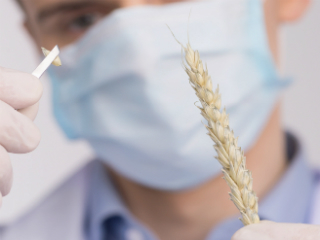 First, non-celiac wheat/gluten sensitivity was a sham and everyone claimed its participants were in a collective mass delusion. Then some actual studies came out, and it appeared to be a real condition. Soon after, researchers offered different theories. Maybe it was FODMAP intolerance. Maybe it was all that wheat fiber messing up the gut. Maybe it was too little fiber and other fermentable substrate, and we were actually starving our gut bugs and compromising our intestinal health. Maybe it wasn’t even the gluten. And maybe it was actually some kind of a placebo. One of the most recent findings was that gluten sensitivity might not even exist. What’s the truth?
First, non-celiac wheat/gluten sensitivity was a sham and everyone claimed its participants were in a collective mass delusion. Then some actual studies came out, and it appeared to be a real condition. Soon after, researchers offered different theories. Maybe it was FODMAP intolerance. Maybe it was all that wheat fiber messing up the gut. Maybe it was too little fiber and other fermentable substrate, and we were actually starving our gut bugs and compromising our intestinal health. Maybe it wasn’t even the gluten. And maybe it was actually some kind of a placebo. One of the most recent findings was that gluten sensitivity might not even exist. What’s the truth?
The response to the controversy in the media has been predictable. Gluten-free was just a fad and we were “dumb” for following it. Paleo and gluten-free are just “lies we tell ourselves,” and they’re literally destroying us. The one upside is this hilarious viral video, but that doesn’t make up for scaring away the people who might really have benefited from avoiding gluten/grains. Or the people who had already benefited but began doubting themselves and reneging on the diet. I don’t have any hard data on the numbers, but I’ve received enough feedback from confused readers wondering whether the real, measurable benefits they’d experienced were all in their heads.
Maybe it’s not.
A new study just out introduces another wrinkle: people who report having “non-celiac wheat sensitivity” show evidence of systemic immune activation and impaired intestinal permeability. In short, NCWS is characterized by leaky gut, increased translocation of gut contents—including microbial toxins—into circulation, and moderate immune reactivity to a gluten challenge. It certainly seems quite real.
How was the study conducted?
Researchers recruited a group of 160 adults. 80 of them were non-celiac wheat sensitives eating a normal diet. 40 had celiac. 40 were healthy controls. They ran a few tests to determine their baseline inflammatory status. Here’s what they found:
NCWS displayed more immune reactivity to gluten than healthy controls, but less than celiacs. This increased reactivity on the part of NCWS was not mediated by the genes typically associated with celiac.
NCWS had elevated biomarkers indicating damage to the intestinal lining. That’s leaky gut, the condition that “rational” types still insist exists only in your imagination.
NCWS had higher lipopolysaccharide-binding protein (LBP) and sCD14 levels than both controls and celiacs. Lipopolysaccharide (LPS) is a bacterial endotoxin with some bad health effects if allowed systemic access. Our bodies dispatch LBP and sCD14 to regulate LPS toxicity, prevent systemic dispersal, and maintain a healthy inflammatory response. High levels of LBP and sCD14 indicate elevated systemic inflammation. NCWS also had elevated bacterial endotxin (LPS) antibodies. This suggests that LPS was making it into circulation—perhaps through a compromised intestinal lining—and eliciting an inflammatory response.
NCWS had elevated flagellin antibodies. Flagellin is the principle protein in Gram-negative and Gram-positive bacteria, and flagellin antibodies are typically elevated during infections involving those bacteria. Since NCWS were not infected, a rise in flagellin antibodies could indicate translocation of bacterial products from the gut into circulation (again, likely through the leaky gut).
Elevated systemic inflammation was linked to intestinal permeability. More damage to the intestinal lining, higher inflammation.
After the baseline measurements, researchers placed 20 of the NCWS subjects on a gluten-free diet for 6 months to determine the effect of gluten avoidance on these biomarkers. Wheat, rye, and barley were all restricted. What happened?
Removing gluten-containing grains improved both intestinal permeability and systemic inflammation. LBP, sCD14, flagellin antibodies, endotoxin antibodies, and leaky gut markers all improved. They showed less reactivity to microbial products leaking through the gut. Their symptoms, which had previously included both intestinal (diarrhea, gas, bloating, pain) and extraintestinal (confusion, fatigue, cognitive decline) complaints, diminished. All in all, removing gluten grains had real benefits that were reflected in both subjective and objective measurements.
It’s a pretty cool study that vindicates much of what you guys have been reporting (and experiencing) for years.
However, it doesn’t identify the source of the problem in these patients. They still don’t know what causes the initial breakdown in intestinal integrity.
I might, though. And I think there are ways to fix it.
I won’t go through every one of the recommendations for preventing and healing leaky gut. You can (and should) read the latter half of this post all about leaky gut where I lay out most of the possible causes and solutions for the condition. Nothing will be too surprising. You’re probably doing most of them. But do read it. It’s a solid piece full of research-backed advice.
For what it’s worth, I’ll discuss my evolving relationship with gluten. I don’t eat it often, but I’ll have the odd piece of crusty bread dipped in olive oil or smeared with butter when I’m at a particularly good restaurant. I’ll use regular soy sauce if it’s around. I’ll have a good beer (hey, it’s a traditionally-prepared grain!) a few times a year. I’ll nibble on a piece of quality cake or pie at a birthday party. Those little bits and bites used to give me grief, but not anymore. I’ve noticed a huge improvement in my reaction to gluten, and I think several things have made the biggest difference.
My training: For over a decade I’ve implored folks to make their long workouts longer and easier and their short workouts shorter and more intense. But since working on Primal Endurance, I’ve really embraced it in a way I now realize I wasn’t. Even four, five years ago my old competitive type A elite endurance athlete self was poking through, prodding me to “do another set, Sisson” and “c’mon, you got another hill/game/circuit/sprint in you.” I’m doing way more long slow movement (hikes, walking, paddling) and I’ve made my hard workouts briefer and more intense than ever. I’m avoiding the protracted intense training that induces leaky gut and favoring the easy stuff that improves it. This has likely improved my gut barrier function.
More collagen: I’m making a concerted effort to eat way more collagen through bone broth, my chocolate bars, gelatinous cuts of meat like oxtails and shanks, and even the occasional shake of powdered gelatin to thicken a pan sauce (seriously, folks: add powdered gelatin to coconut curry sauce and be rewarded). Collagen is great for the gut.
Less (and better) wine: Back when I did my no-drinking self-experiment, I found that both my sleep and my gut health improved. Drinking natural, dry-farmed wine lower in alcohol and free of adulterants has preserved those effects while allowing me to imbibe.
More fermentable fiber: Several years ago I began feeding my gut bacteria more regularly with fermentable substrates like inulin and resistant starch. Green bananas for smoothies, unmodified potato starch, dark chocolate, and all the fibrous vegetation I can get have made those gluten dalliances more tolerable.
Now, whether my recommendations will work for you remains to be seen. I’m optimistic, though.
That’s about it, folks. Thanks for reading and be sure to leave your comments, experiences, advice, criticisms, and anything else down below!
Like This Blog Post? Subscribe to the Mark's Daily Apple Newsletter and Get 10 eBooks and More Delivered to Your Inbox for FREE



August 2, 2016
10 Ways to Beat the Low-Carb Flu
 The low-carb flu is real and it’s terrible. While it doesn’t kill as many as the Spanish flu of 1918 did or inspire the amount of panic seen during the 2009 swine flu epidemic, low-carb flu has dissuaded millions of people from pursuing and sticking to a healthy diet. You can laugh now that you’re fat-adapted and humming along on stored body fat, but you’ve forgotten just how terrible the transition from sugar-burning to fat-burning can be. Do any of the following symptoms sound familiar?
The low-carb flu is real and it’s terrible. While it doesn’t kill as many as the Spanish flu of 1918 did or inspire the amount of panic seen during the 2009 swine flu epidemic, low-carb flu has dissuaded millions of people from pursuing and sticking to a healthy diet. You can laugh now that you’re fat-adapted and humming along on stored body fat, but you’ve forgotten just how terrible the transition from sugar-burning to fat-burning can be. Do any of the following symptoms sound familiar?
Crippling headaches.
Brain fog so thick you almost welcome the headaches for cutting through it.
Malaise, fatigue, listlessness, and other synonyms for “exhaustion.”
Lightheadness and dizziness.
Irritability.
A sense of impending doom that you suspect would give way to bliss if only you’d have some ice cream.
At some point, you’ll just have to accept the reality of the situation: you’re shifting from a sugar-burning metabolism to a fat-burning metabolism. You’re building the metabolic machinery necessary to burn fat. You’re updating your body’s firmware, and it’s a big update (coincidentally, this is why I recommend plugging into a power source for the duration). That takes time. If the results of one study are representative, it takes about five days on a low-carb, high-fat diet to increase AMPK and start building new fat-burning mitochondria. And sure enough, most people report that the low-carb flu lasts from 4-7 days—right on target.
But that doesn’t mean we have to like it. So, what can you do to speed up the transition and/or reduce the pain and suffering?
1. Eat fatty fish or take fish oil
One theory is that low-carb flu is caused by the release of stored arachidonic acid from adipose tissue. Since AA is the precursor to inflammatory molecules implicated in headaches, a sudden rush of AA into the blood—as happens in obese and overweight people during initial weight-loss—could be responsible. If this is true, taking extra fish oil or eating fatty fish like sardines or salmon should counter the omega-6-induced inflammatory response triggering the headaches. If this isn’t true, eating fish is still a good idea.
2. Don’t skimp on salt
Going low-carb increases salt requirements on multiple levels. First, when your body dumps glycogen, it doesn’t just dump the water that accompanies it. You’re also losing tons of sodium. Second, a byproduct of low insulin is reduced sodium retention, so you’re both losing and failing to hold on to it. Third, going on a Primal eating plan inevitably entails eating more fresh food and less unprocessed food. Unprocessed food is usually low-salt; processed food often comes with added salt. Nothing a little extra salt can’t fix.
Add salt to taste. Drink salty bone broth (Peter Attia likes bouillon dissolved in hot water, but I prefer the real stuff). Sprinkle a little salt in your water.
3. Eat enough potassium
You also lose potassium when you go low-carb and dump all that water weight. To replenish your stores, Use Lite-Salt (a potassium salt) along with your regular salt, and eat lots of non-starchy green vegetation, like spinach. Other great potassium sources include avocados and yogurt (if you get real yogurt, the bacteria have consumed most of the sugar).
4. Take magnesium
Although losing water doesn’t really flush out magnesium like it does other electrolytes, we do need extra magnesium to regulate sodium and potassium levels in the body. Leafy greens like spinach (again) are great sources of magnesium, as are most nuts and seeds. I just found a sack of sprouted watermelon seeds at Costco that give you 35% of the RDI for magnesium per ounce. Even though low-carb and sweeteners don’t usually mix, I’d say the huge amount of magnesium in blackstrap molasses makes a tablespoon worth adding.
You may have to dip into the supplement bin for this one. Any magnesium ending in “-ate” will do: glycinate, citrate, malate, etc. And once again, it’s one of those cases where almost everyone can probably use extra magnesium regardless of their current diet. It’s simply a good nutrient to have.
5. Stay hydrated
People tend to focus on the electrolytes you lose with water loss, but there’s also the water. If you’ve ever been dehydrated, you know the symptoms—dizziness, fatigue, mental confusion—match those of the low-carb flu. Pay attention to your thirst and get yourself a good source of mineral water with a TDS of at least 500 mg/L (or make your own using Trace Mineral drops), like Gerolsteiner, to boost your intake of minerals that may be lost to water shedding. Don’t drink healthy-sounding things like reverse osmosis water without remineralizing it.
6. Eat more fat
The study I cited earlier in which a low-carb, high-fat diet increased AMPK had another experimental group who also experienced AMPK upregulation: lean adults given a bunch of fat to eat. It turns out that both carbohydrate restriction and fat feeding can increase AMPK activity. In both instances, the amount of fat available for burning increases. By supplementing your endogenous fatty acids (the stuff coming off your body fat) with exogenous fatty acids (fat you eat), you can maximize the AMPK activation and, hopefully, speed up the adaptation process. You may not lose as much body fat this way, but you’ll be happier, less fatigued, and more likely to stick with the diet.
7. Include some medium chain triglycerides (MCTs) in that fat
MCTs are treated differently than other fats. Rather than store them in the body fat or use them in cell membranes, the body sends them directly to the liver for burning or conversion into ketones. So a good percentage of the MCTs we eat become ketones, which provide some additional fuel to glucose-deprived bodies that haven’t quite adapted to a fat-based metabolism. Coconut fat is the natural source of MCTs, though only about 14-15% of the fatty acids in coconut oil are MCTs. If that’s not giving you the boost you need, MCT oil is an isolated source of the ketogenic fatty acids. You can go even further and get just caprylic acid-based MCT oil, which isolates the specific fatty acid with the most ketogenic potential.
8. Consider ketone supplements
Part of the low-carb flu comes down to poor energy availability: when you take away the energy source you’ve been relying on all your life, it takes awhile to feel normal. Similar to MCTs but more so, ketone esters “force” ketone availability. And while I’m skeptical of taking large amounts of supplemental ketones on top of a high-carb diet (so are others), I can imagine them helping the newly low-carb speed up the adaptation process and overcome the low-carb flu.
9. Move around a lot at a slow pace
If you haven’t read Primal Endurance, consider grabbing a copy. It really fleshes all this out. But long story short? Hold off on the extended sugar-burning training—long CrossFit WODs, long hard endurance efforts, 30 minute interval workouts, P90X—until you’re fat-adapted. Do some intense stuff, but keep it really intense and brief. Short 2-5 rep sets of full body lifts, brief 5-10 second sprints (with plenty of rest in between), things like that. The bulk of your training should consist of easy movement keeping your heart rate in the fat-burning zone (180 minus your age) until you’re adapted and the low-carb flu has abated. Hikes, walks, light jogs, cycling, swimming are all great depending on your level of fitness, and they’ll jumpstart the creation of new fat-burning mitochondria to speed that process up.
10. Reduce carbs gradually
The vocal ones, the people who post on message boards and leave comments and submit success stories, are generally going to be more extreme. They’re going from 400 grams of carbs a day to 40 grams. They’re going all in. They’re going cold turkey (literally: they’re eating entire meals consisting entirely of cold turkey to avoid carbs). That doesn’t work for everyone.
Another option, and one that might work even better for most people, is to gradually reduce carbs. By reducing carbs more gradually you reduce the shock to your system and give your body the chance to find its sustainable sweet spot. You might do best on 150 grams a day (that’s about where I am, in fact). You might like 120, or 130, or 70. The point is going gradually allows you to take a journey through all the possible permutations of carb/fat/protein intake. It’s quite possible that 140 grams a day works best for you, but because you immediately launched into a very low-carb 20g/day diet and failed miserably, you’re turned off from the idea altogether.
That’s what I’ve got, folks. Those are the tips that work best for me and mine. Those are the tips that science suggests actually work. What about you? How have you gotten over the low-carb flu?
Thanks for reading, everyone. Take care.
Like This Blog Post? Subscribe to the Mark's Daily Apple Newsletter and Get 10 eBooks and More Delivered to Your Inbox for FREE



August 1, 2016
Dear Mark: Coffee Talk
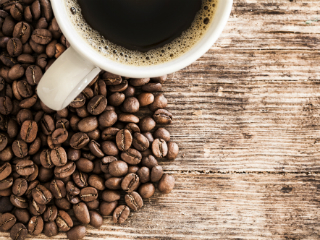 Last week’s post on coffee generated lots of questions. Today’s Dear Mark will answer some of them. First up is a two parter exploring whether L-theanine can make coffee work even better than it already does and if pre-ground coffee beans are lacking in the polyphenol content. Second, is coffee bad for your bones? It’s “common knowledge” that caffeine leaches calcium and inhibits absorption of it, but how true are the claims? And finally, caffeine can increase insulin resistance. What about coffee? Is this a problem for people following the Primal eating plan?
Last week’s post on coffee generated lots of questions. Today’s Dear Mark will answer some of them. First up is a two parter exploring whether L-theanine can make coffee work even better than it already does and if pre-ground coffee beans are lacking in the polyphenol content. Second, is coffee bad for your bones? It’s “common knowledge” that caffeine leaches calcium and inhibits absorption of it, but how true are the claims? And finally, caffeine can increase insulin resistance. What about coffee? Is this a problem for people following the Primal eating plan?
Let’s go:
Mark, I have a few questions because I’ve been waiting for a definitive guide to coffee. First, about the cortisol, I was wondering if supplementing l-theanine would reduce the negative stress inducing effects the caffeine has similar to how a cup of green tea acts? Second, I’ve read from many different sites that pre-ground coffee has a substantial reduced amount of antioxidants compared to freshly ground beans. Also, thanks for the info on inorganic coffee. I had a friend tell me only buy organic because of the pesticide residue content.
1. Many in the nootropics community take it alongside their coffee (or caffeine powder). There’s a fair amount of research into the combination.
50 mg of caffeine with 100 mg of L-theanine improved performance in an attention-switching task and reduced susceptibility to distracting stimuli.
Compared to either alone, caffeine (150 mg) with L-theanine (250 mg) led to improved word and sentence recall, faster reaction time, improved rapid visual information processing, and less mental fatigue.
If caffeine raises your blood pressure, L-theanine blunts the effect.
L-theanine had no effect on the caffeine-mediated increase in vigilance on a task requiring sustained attention.
L-theanine inhibited the vasoconstrictive effects of caffeine in one recent study, but also eradicated the positive mood changes.
L-theanine may be a good addition to coffee, depending on what you’re trying to do. For focusing on the task at hand and getting things done, coffee with L-theanine might be the ticket. For people who get the jitters and the shakes from coffee, add a little L-theanine. If you’re looking for the mood effects of caffeine—that dose of “productive optimism” that makes idea generation run smoothly—you may prefer coffee alone.
As always, your mileage will vary. Try it out—a cup of strong green tea is a good source of L-theanine, and L-theanine supplements exist for relatively cheap—and see how it affects your coffee high. It’s not going to do any damage, and even if you don’t end up using it with coffee, L-theanine is a good thing to have around for general anxiety and stress.
2. Yes, this is partially true. Polyphenols exist not to provide health benefits to us (although it’s a nice side effect) but to protect the plant from oxidative stress. Just as light and heat exposure degrades the polyphenol content of extra virgin olive oil, rupturing the cell walls of a coffee bean and increasing the surface area exposed to the elements through grinding degrades its polyphenol content. It’s not actively bad for you. It’s just probably not as good. Nor does it taste as good.
I enjoyed your article on coffee, however I would like to know what the correlation is between caffeinated coffee and calcium intake or even if there is one. A number of years ago I had a serious spiral fracture to my leg and my doctor told me not to consume caffeine as is inhibited calcium from being absorbed by the bones. Any truth to this?
Thanks
Leslie Stevens
Thanks for the kind words, Leslie. I’m glad you liked the post.
Luckily for you, this claim appears to be over hyped if not altogether incorrect. Just like the popular notion of animal protein leaching calcium from your skeleton and turning your blood into bone broth, the reverse may even be true: coffee consumption has even been linked to lower rates of osteoporosis and improved bone mineral density.
Overall, observational (correlational) studies find a small link between coffee consumption and fracture risk in women. They find the opposite in men: coffee intake is protective against fractures.
A controlled trial in healthy premenopausal women found that 400 mg of caffeine a day had no significant effects on calcium economy, including urinary calcium, fecal calcium, or calcium absorption. There were slight decreases in bone resorption (transfer of calcium from bone to blood), bone accretion (transfer of calcium from blood to bone), and calcium pool turnover (less activity in the bone all around).
In Swedish women, high coffee consumption is linked to a minor reduction in bone mineral density (3-4%) but not increased fracture risk. This relationship was strongest in women who consume less than 700 mg of calcium a day, who did have an increased risk of fracture.
In premenopausal Korean women, coffee intake has no correlation to bone mineral density.
In postmenopausal Korean women, coffee intake has a protective relationship with bone mineral density.
Caffeine has a very slight inhibitory effect on calcium absorption. It’s so slight that a mere tablespoon or two of milk provides enough calcium to make up for any calcium lost to your daily coffee.
What else could explain a damaging relationship?
High caffeine intake is very often a marker for low calcium intake. The more coffee (and energy drinks) a person consumes, the less dairy (the most common source of calcium in Western diets) they tend to consume. A low calcium intake exacerbates the otherwise minor effect caffeine has on calcium economy.
High coffee intake can be a marker for poor sleep. Sleep loss is strongly linked to bone loss. Caffeine not only affects sleep when taken late in the day, it’s frequently used by people who sleep poorly and need it to stay awake and alert.
That said, limiting coffee (and caffeine) while healing from a fracture may be prudent. Animal studies indicate that caffeine has a direct effect on the bone healing process, when even small perturbations to calcium economy are significant.
So while you shouldn’t adopt a pot a day habit while recovering from bone injuries, healthy people shouldn’t be too concerned. If you do drink a lot of coffee, make sure you’re eating enough calcium (and protein, and vitamin D, and vitamin K2, and collagen, and lifting heavy things, and all the other things that determine bone health).
In a previous post, I believe it was a “Dear Mark,” you mentioned that coffee could temporarily increase insulin resistance, which makes that fact that many on a SAD diet pair coffee with a pasty especially bad.. Is it coffee specifically, or caffeine that triggers insulin resistance?
Caffeine is “worse” than coffee, to be sure. Coffee has protective polyphenols, like chlorogenic acid, with proven benefits on insulin sensitivity. Caffeine does not.
And coffee consumption appears to be protective against liver damage, correlating with lower liver fat levels and improved liver enzyme numbers. Another study found that high liver enzymes tend to predict insulin resistance. If coffee improves liver enzymes, it’s probably improving insulin resistance, too.
Another study found that low-energy diets either high in coffee or low in coffee led to similar improvements in insulin sensitivity.
And still another study, this one a controlled trial, gave type 2 diabetics (some of the most insulin resistant folks around) 5 cups of coffee every day. Although 8 weeks weren’t enough to see any changes to insulin sensitivity, their liver function—a likely harbinger of insulin sensitivity—did improve.
You read the post from several years ago, so you know that the increase in insulin resistance sometimes caused by coffee/caffeine is entirely physiological: coffee increases adrenaline, which releases stored fat, and we need to be a little insulin resistant to burn that fat effectively.
Of course, this means that a big mug of coffee alongside a plate of pancakes isn’t a great idea. But most of my readers aren’t eating big plates of pancakes. Right?
That’s it for today, folks. Take care and be sure to help out with your own input down below.
Like This Blog Post? Subscribe to the Mark's Daily Apple Newsletter and Get 10 eBooks and More Delivered to Your Inbox for FREE



July 31, 2016
Weekend Link Love – Edition 411
 Why everyone could benefit from a health coach (plus, my personal experience with one). Learn more at primalhealthcoach.com.
Why everyone could benefit from a health coach (plus, my personal experience with one). Learn more at primalhealthcoach.com.
Research of the Week
Eating produce could make you happier (a dose response relationship).
How prenatal and postnatal factors affect a baby’s microbiome, and what it implies about long-term development (PDF).
A 90 minute walk in the woods brightens your mood and kills self-rumination.
White rice privilege: rice used to be a whole lot more diverse.
Now that’s philanthrophy: astrocytes donate their mitochondria to neurons after strokes.
Ad-libitum low-carb diets are more effective and easier to stick to than calorie-restricted diets.
When battling colon cancer, taking fish oil or eating fatty fish may help.
Badgers fear humans more than any other predator.
Adding dietary glutamate (fish sauce, soy sauce, aged cheese) to specific foods can train people to like those foods.
Low-level aerobic activity (brisk walking, in this example) better than chronic cardio (vigorous jogging, in this example) for pre-diabetics.
Is there a thrifty gene after all? Perhaps in Samoans.
New Primal Blueprint Podcasts

Episode 128: Cassie Parks: Host Elle Russ chats with Cassie Parks about the law of attraction, the benefits of positive energy, the pitfalls of telling too many stories about yourself, the uselessness of worrying, and much much more.
Each week, select Mark’s Daily Apple blog posts are prepared as Primal Blueprint Podcasts. Need to catch up on reading, but don’t have the time? Prefer to listen to articles while on the go? Check out the new blog post podcasts below, and subscribe to the Primal Blueprint Podcast here so you never miss an episode.
Boring May Be Better: Why Routine May Be Best for Certain Health Goals
3 Common Types of Headache (and How to Treat Them Naturally)
Interesting Blog Posts
The growing (and totally avoidable) myopia epidemic.
Mating with your cousin has definite downsides, but could it protect against autism?
Media, Schmedia
Chimps are ignorant about others’ ignorance.
British teen planning scramble beats the odds, discovers all dozen eggs have double yolks.
Everything Else
The fight against obesity starts before birth.
Bug producers are forming lobbyist groups to hasten edible insect acceptance.
CRISPR humans are coming (in China).
Who’s up for cockroach milk?
AI gets its own literary magazine.
The US is awash in rancid extra virgin olive oil because, well, most Americans prefer the taste.
Nature is beautiful, but it’s trying to kill you.
Avid cyclist Chris Froome cut carbs and increased protein to lose body fat and increase his power-to-weight ratio. Oh, and also to win his third Tour de France in four years.
Recipe Corner
Dry-brine your pork chops.
Curry turkey bites with ginger-apricot sauce.
Chipotle potato salad made with PRIMAL KITCHEN™ Chipotle Lime Mayo.
Time Capsule
One year ago (Jul 31 – Aug 6)
How Important is Consistency in Fitness? – It’s a huge part.
An Introduction to Isometrics: How to Build Strength Without Even Moving – Simple but not easy.
Comment of the Week
Battle of the productivity tools. I nominate PowerPoint, Ben and Nocona.
Like This Blog Post? Subscribe to the Mark's Daily Apple Newsletter and Get 10 eBooks and More Delivered to Your Inbox for FREE



July 30, 2016
Roasted Berry Parfait
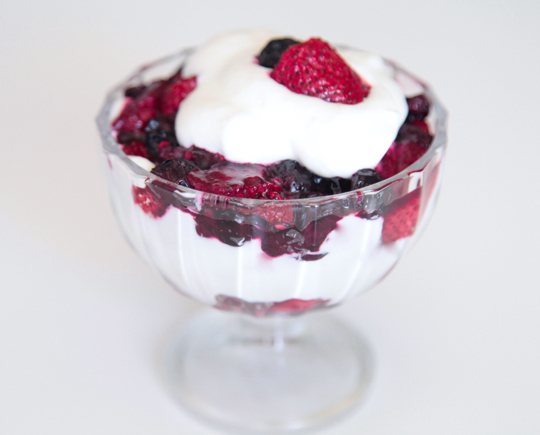 Berries are nature’s way of handing you the perfect dessert. Sweet and pleasurable to eat, berries also have some of the highest antioxidant ratings of all fruits.
Berries are nature’s way of handing you the perfect dessert. Sweet and pleasurable to eat, berries also have some of the highest antioxidant ratings of all fruits.
A bowl of fresh, ripe berries is splendid, for sure, but this parfait made from layers of roasted berries and whipped cream is over-the-top deliciousness.
Roasting berries bring out their sweetness, a handy trick when berries aren’t quite as ripe as you’d like. The flavor of roasted berries is richer, tasting more like pie filling than fresh berries. Layered with whipped cream (made from either coconut milk or whipping cream), the roasted berries turn into a gorgeous, healthy and decadent-tasting dessert.
Servings: 6
Time in the Kitchen: 35 minutes
Ingredients:
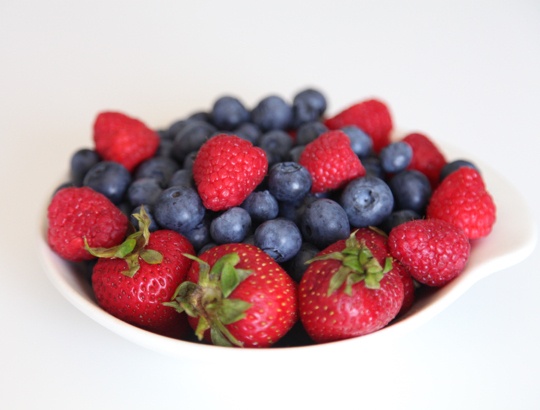
24 ounces fresh berries (about 2 pints) (680 g)
1 tablespoon maple syrup (15 ml)
2 tablespoons coconut oil (30 ml)
1 teaspoon vanilla extract ( 5 ml)
Pinch of salt
1 13.5 ounce can (400 ml) full-fat coconut milk, refrigerated overnight, or 8 ounces (236 ml) heavy whipping cream
Instructions:
Preheat oven to 450 °F/232 °C. Line a large rimmed baking sheet with parchment paper.
If using strawberries, hull and quarter the berries.
In a large bowl combine the berries. Pour the maple syrup, coconut oil, and vanilla extract over the berries. Add a pinch of salt. Gently mix.
Spread the berries out evenly in one layer on the baking sheet.
Roast 25 minutes (do not stir).
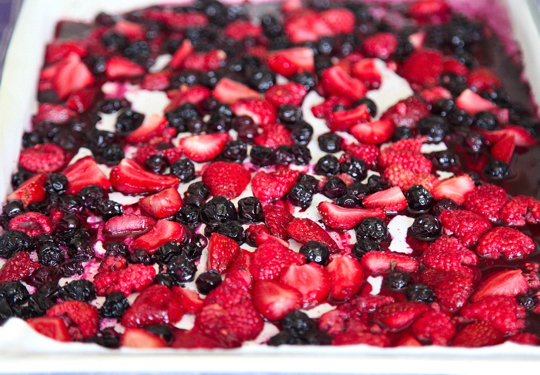
While the berries are roasting, put a mixing bowl in the freezer to chill for 20 minutes or so.
If making coconut whipped cream, open the can of chilled coconut milk and scrape the solid coconut cream into the chilled mixing bowl, without disturbing the liquid. Save the liquid for another use, like smoothies.
Beat for about 2 minutes. If desired, add maple syrup or sugar to sweeten.
If using whipping cream, beat the cream in the chilled mixing bowl until it turns into whipped cream. If desired, add maple syrup or sugar to sweeten.
In clear glasses or bowl, layer the cooled berries and (coconut) whipped cream.
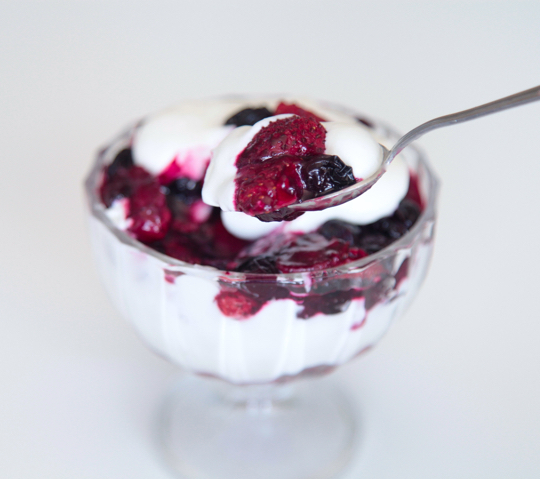
Not Sure What to Eat? Get the Primal Blueprint Meal Plan for Shopping Lists and Recipes Delivered Directly to Your Inbox Each Week. Now Available as an App!



Mark Sisson's Blog
- Mark Sisson's profile
- 199 followers




